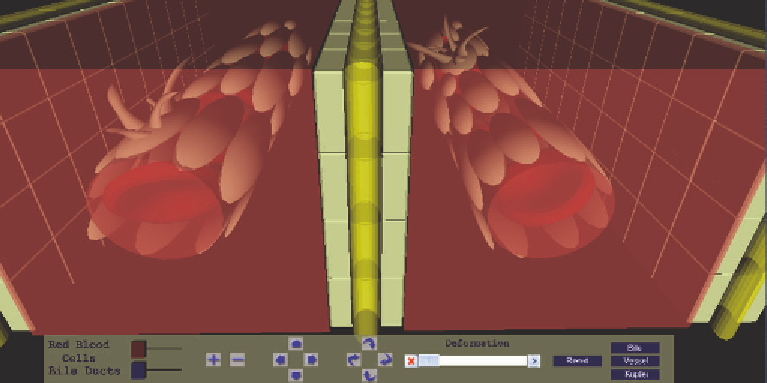Graphics Programs Reference
In-Depth Information
able to perceive easier the interface of the
system. The entrance is the first virtual
world of the application and it leads stu-
dents to the three other educational rooms:
classroom, lab and library.
screen, which reproduces videos from real
lectures. The video is assigned as a tex-
ture on the virtual screen, while students
can handle it (start, stop) using buttons lo-
cated on the upper part of the screen. The
second role of the virtual lab is to connect
the physical learning environment with the
simulation of the application. Specifically,
students interact with the virtual micro-
scopes, which are active objects of the
virtual world and transfer students to the
simulation of hepatic cells.
•
Classroom:
The virtual classroom plays a
significant role in the learning process re-
producing conditions developed in a real
university classroom. Students participate
in the learning process, in which they have
direct access to the educational material
(images and text) through their interaction
with a virtual board. Specifically, as shown
in Figure 6a, the virtual board is divided
in five parts. The bottom of the board al-
lows students to choose the course (e.g.
Histology-Embryology I) and its left part
contains the chapters of each course. The
educational material is presented at the
centre (images) and the right part (text) of
the board, while special buttons on the up-
per part allows the browsing of the educa-
tional content.
•
Library:
The virtual library provides
connections with external data sources.
Specifically, students are able to navigate
within the virtual world of the library
searching for knowledge and interact with
virtual objects (books, signs etc), which
connects to external information sources
(e.g. e-libraries) containing relative educa-
tional content (Figure 6b).
•
Simulation:
The simulator is a real-time
interactive application, which allows the
study of a specific pathological condition
and the cellular structure of human liver
(Figure 7). The simulation represents in 3D
space a characteristic portion of the cellu-
•
Laboratory:
The lab of the application
plays a dual role. Primarily, its role is to
allow students to attend virtual lectures.
This can be achieved through a virtual
Figure 7. The simulation of hepatic cells

Search WWH ::

Custom Search